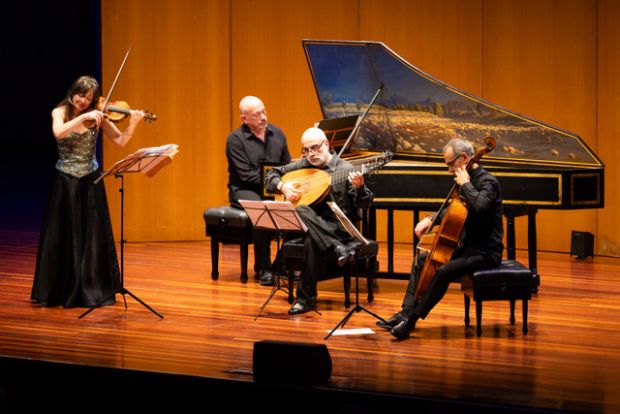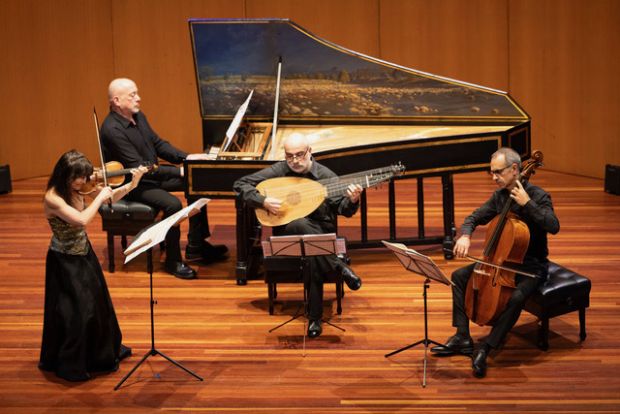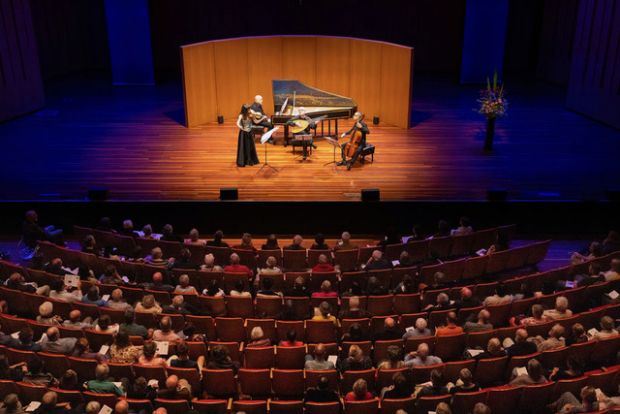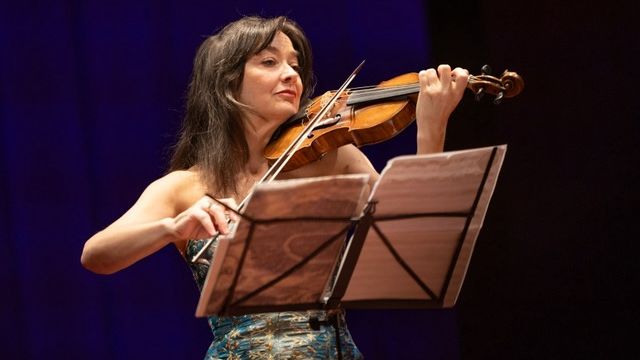Musica Alchemica
Musica Alchemica is described as a ‘magical mystery tour’ of Baroque music! One hundred and forty minutes starring eight composers of the Baroque period – Biber, Cima, Schmelzer, Muffat, Corelli, Telemann, Piccini, and von Westoff. I must confess to some extra research before attending as some of these composers are not in the Baroque mainstream.
Musica Alchemica is headed by Spanish violinist Lina Tur Bonet. For its eight-concert tour of Australia, which began in Canberra, she brings a handpicked group of Europe’s finest baroque musicians in Marco Testori (baroque cello), Giangiacomo Pinardi (archlute) and Kenneth Weiss (harpsichord).
The first half of the programme features works from the 17th Century - Heinrich Ignaz Franz Biber’s Sonata No. 1 in D minor ‘The Annunciation’ from the Mystery (or Rosary) Sonatas ranks among the most challenging works in the Baroque violin repertoire, and his experimentation with the instrument is groundbreaking. Heard as a collection, they are astonishingly powerful and deeply emotional.

Biber instructs the violinist to tune the strings differently from the way they are conventionally tuned, so that no two sonatas have the strings tuned to the same set of notes.
Bonet makes her entrance down the centre aisle of the Adelaide Town Hall while playing dramatically to emulate the Virgin Mary coming to meet the Archangel Gabriel.
This is a sensitive piece and Musica Alchemica handle it with reverence with sweeping phrases from Bonet on violin.
Giovanni Paolo Cima’s Sonata a 2 is a conversation of sorts between violin and cello in which they swap phrases. With little ornamentation, it is dependent on timing and technique. It was fascinating to watch the cueing between Bonet and Pinardi to ensure accuracy.

Johann Heinrich Schmelzer’s Sonata Quarta in D major is a set of variations based on four descending notes, though in the major rather than the minor. Featuring frequent ornamentation and virtuosic violin passages, beautifully played by Bonet, the sonata finishes with a free bravura passage.
Georg Muffat’s Passacaglia in G minor for harpsichord is a baroque dance variation form on a short melodic formula usually occurring in the bass. Heavily ornamented, one can easily picture Salieri or even Mozart sitting at the harpsichord. Weiss makes the complex score seem easy.
Biber’s Sonata No. 10 in G minor ‘The Crucifixion’ is a fitting finish to the 17th Century section of the evening. Outlining Jesus’ crucifixion, it is gnarly and grotesque in all the right places. The section depicting hammering the nails into Jesus’ cross is particularly striking. This is a difficult piece of music and Bonet’s furious bowing technique is amazing to watch.
The second half of the concert takes into to the 18th century and the music of Corelli, Telemann, Piccini and Westoff -
Arcangelo Corelli‘s Violin Sonata in G minor, Op. 5 No. 5 is his one and only set of violin sonatas, and arguably the finest and most influential ever assembled. The outstanding feature is the freedom of ornamentation employed. An audience favourite and mine, this is an intense piece of music.
Georg Philipp Telemann’s Sonata for Cello in D major is a haunting piece. In four movements for just archlute, harpsichord, and cello, the music travels from the plaintive to the joyful, Testori makes the cello ‘sing’ and features some intricate archlute work by Pinardi.
Alessandro Piccinini’s Toccata is part of the two volumes of lute music, the second published posthumously, and is credited with various developments to instruments of the lute family. Featuring clever use of the bass fretboard, Pinardi demonstrates his mastery of the archlute.

Johann Paul von Westoff’s Imitazione del liuto is a cheeky piece using violin pizzicato to imitate a lute. A happy combination of lute and violin, it is a joy to listen to and by the looks on the performer’s faces, a joy to play as well!
Corelli’s Violin Sonata in D minor, Op. 5 No. 12 ‘La Folia’ is a fitting climax to the evening. The folia (sometimes follia), which originated as a dance or dance song in Portugal, had already become popular by the time it was first referred to in writing in the fifteenth century. A well-known piece played to perfection, featuring some frenetic violin work.
My only reservation during the evening was the uneven sound balance at times which resulted in the harpsichord not being heard often when the whole ensemble played. Musica Alchemica would achieve the intimacy needed in a smaller setting.
Musica Alchemica is a glorious evening of Baroque music played by experts in their fields. It is a hundred minutes of 17th and 18th Century heaven!
Barry Hill OAM
Photographer: Ari Schlumpp
Subscribe to our E-Newsletter, buy our latest print edition or find a Performing Arts book at Book Nook.

